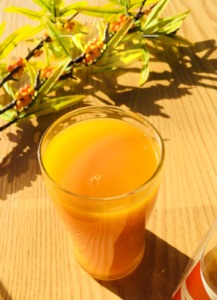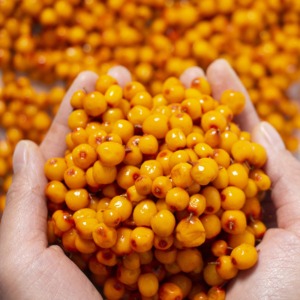Hippophae rhamnoides, also known as sea buckthorn, is a good plant, as it is a rich source of valuable bioactive components. Several studies have investigated its broad biological properties, and its uses range from the medical and cosmetic fields to the industrial food sector. The whole plant is rich in bioactive antioxidant and immunomodulating compounds, and hippophae rhamnoides berries, leaves, and seeds are widely used for nutraceutical and medicinal purposes.
In the context of the search for natural compounds that can be used for the control of Gastrointestinal nematodes (GINs) in small ruminants, this plant was selected and tested for evaluating its anthelmintic properties in vitro while also considering the presence in its composition of chemical classes of compounds, especially polyphenols, the antiparasitic activity of which has been previously reported in the literature. Moreover, the juices tested in this study are commercialized for human consumption, ensuring the low toxicity of these products.
 Sea buckthorn (hippophae rhamnoides) juice was tested in vitro to evaluate their potential anthelmintic properties. Contextually, their chemical profiles were characterized to identify their main constituents.
Sea buckthorn (hippophae rhamnoides) juice was tested in vitro to evaluate their potential anthelmintic properties. Contextually, their chemical profiles were characterized to identify their main constituents.
The main bioactive compounds reported for their anthelmintic activity against GINs are polyphenols, particularly condensed tannins and flavonoids, although other chemical classes of compounds have also been reported. Polyphenols constitute a wide class of compounds, and according to most of the literature, they are divided into phenolic acids, lignans, stilbenes, and flavonoids. The total polyphenols content of sea buckthorn juice from fruits of plants was previously determined to be 4784 ± 35 mg GAE/L. The values we obtained for the SBT and SBF aligned with the reported values. Polyphenols were identified using quercetin, isorhamnetin, isorhamnetin-3-glucoside, myricetin, rutin, epicatechin, gallocatechin, and kaempferol as standards, considering that they are included among the most important compounds of sea buckthorn berries and leaves. In the SBT and SBF, we examined, several peaks were present in the same range of minutes in some cases; therefore, the assignment of the correct identification to standard compounds was challenging, and an HPLC-MS was also performed to confirm the identity of the compounds.
Moreover, a single standard compound was used to quantify isorhamentin-similar molecules, considering that the glycosides bonded to isorhamentin do not affect the absorbance at UV at 360 nm. Using a single standard compound to refer to similar compounds is, in fact, common. Moreover, not all compounds are always commercially available to be used as standards.
Generally, sea buckthorn is rich in flavonoid glycosides, including I-3-O-rutinoside, I-3-O-glucoside, Q-3-O-rutinoside, Q-3-O-glucoside, I-3-O-glucoside-7-O-rhamnoside, K-3-O-sorphoroside-7-O-rhamnoside, I-3-O-sorphoroside-7-O-rhamnoside, and rutin. Flavonoids form a major subgroup within phenolic compounds in sea buckthorn. Their total concentration in berries may range from 1680 to 8590 mg/kg, which is several times higher than in other flavonoid-rich plants such as blackberries or dog roses. The most common aglycons in berries are kaempferol, quercetin, myricetin, and isorhamnetin.
This study uses isorhamentin-3-rutinoside, isorhamentin-3-neohesperoside or isorhamentin-3-glu-7-rha, quercetin-3-galactoside, and quercetin-3-glucoside were the most represented compounds. These results also agreed with previously reported studies that flavonol glycosides were the most abundant phenolic compounds in sea buckthorn, particularly isorhamentin glycosides. However, while the chemical analyses of SBF and SBT showed that both were characterized by a very similar biochemical profile and flavonoid composition, the intensities of the single peaks, e.g., the concentrations of each compound, were different.
The anthelmintic activity of some of the compounds identified in the juices was already reported on Haemonchus contortus, a nematode considered the most relevant GIN species in small ruminants was found to be prevalent among the GIN genera/species identified in this study. Among these compounds, the flavonol narcissin (isorhamnetin-3-rutinoside) was included among the main active compounds from sainfoin, causing a significant reduction in the motility of the larvae of the GIN species H. contortus. Nematocidal activity against H. contortus eggs and larvae of isorhamnetin from Prosopis laevigata leaves was reported by scientists.
Moreover, alterations of the cuticle of H. contortus L3 larvae, but no significant alterations of eggshell surface, were observed after exposure to isorhamnetin. Therefore, the high inhibition effects on larvae of both juices and the high inhibition of egg hatching observed for SBT could be associated, at least in part, with the presence of isorhamnetin-3-rutinoside and other isorhamnetin glycosides in both extracts. On the other hand, differences in the in vitro anthelmintic activity observed for the two extracts could be ascribed to the different concentrations of isorhamnetin glycosides.
Quercetin-3-galactoside and quercetin-3-glucoside were also identified in both extracts. Therefore, we supposed these compounds could play a role in their in vitro anthelmintic effects. In support of this, it was observed that a crude ethanol extract of the aerial parts of Artemisia campestris capable of inhibiting egg hatching and causing death and paralysis in adults of H. contortus predominantly contained derivatives of the flavonol quercetin and the flavone apigenin. The inhibition of GIN L3 motility by quercetin was reported. Similarly, the inhibition of Trichostrongylus spp. L3 motility was reported for quercetin-3-O-glucopyranoside from Vicia pannonica. The flavonoid quercetin was very efficient in inhibiting H. contortus larval exsheathment, even at a very low concentration (250 µM).
To better understand the influence of polyphenols on the in vitro AH effects of tested compounds, PVPP (polyvinylpolypyrrolidone) was added to the two juices. This substance is water-insoluble but highly hydrophilic and binds water through its carbonyl functionalities via hydrogen bonding. Hydrogen bonding is the primary mechanism for PVPP to bind flavonoids and other phenolic compounds.
Therefore, if a loss of anthelmintic activity is observed after PVPP exposure, it can be assumed that polyphenols are most probably responsible for the anthelmintic activity. In this study, the addition of the PVPP did not significantly diminish the anthelmintic efficacy of the juices in vitro, except for SBT in the EHT. Within each class of flavonoids, binding increased with the number of hydroxyl groups, with the exceptions of kaempferol, and consequently, the derivatization of hydroxyl groups resulted in significantly diminished binding.
Moreover, they found that the effect of glycosylation on binding was powerful since hydrogen bonding to PVPP via a potential hydroxyl functionality was blocked, and access to PVPP by other hydroxyls in the molecule was hindered.
Another study highlighted that a higher amount of PVPP should be used to bind rutin concerning catechin, showing that the disaccharide rutinose attached to rutin caused a steric hindrance. Therefore, the lack of anthelmintic reduction after PVPP exposure observed in this study can be ascribed to the high glycosylated compounds in the two sea buckthorn juices, per previous data.
Another possible explanation could be that the ratio of PVPP was insufficient to cope with the high phenolic content of the extracts. These results may also imply that the standard concentration of PVPP generally used in studies evaluating the anthelmintic properties of plant compounds, as in this study, may not be enough to ascertain the role of the polyphenolic fraction in the anthelmintic activity of a plant extract. However, the possibility that other secondary metabolites also could be involved in the observed anthelmintic effects of sea buckthorn juices examined here cannot be completely ruled out.
These results may also imply that the standard concentration of PVPP generally used in studies evaluating the anthelmintic properties of plant compounds, as in this study, may not be enough to ascertain the role of the polyphenolic fraction in the anthelmintic activity of a plant extract. However, the possibility that other secondary metabolites also could be involved in the observed anthelmintic effects of sea buckthorn juices examined here cannot be completely ruled out.
Little is known about the mechanisms by which flavonoids can exert AH activity, as most of the available studies specifically investigated tannins and their mechanisms of action rather than flavonoids. Besides larvae, flavonoids also have strong anthelmintic effects on eggs, inhibiting egg hatching, unlike most condensed tannins. Flavonoids are internalized by worms efficiently, followed by strong metabolization, and might act against molecular targets inaccessible to condensed tannins.
On the other hand, it was suggested that flavonoids act through mechanisms similar to those of tannins. More specifically, they may bind to the nematode shell, sheath, and cuticle, causing the blockage of osmotic exchanges, loss of flexibility, and interaction with proteins responsible for the egg hatch.
Moreover, glycosylation seems very important in promoting flavonoid bioavailability in the nematode. Quercetin-3-O-glucoside is most likely absorbed from the intestine via active transport and is deglucosylated to the aglycone quercetin by β-glucosidases, showing a lower activity than the respective glycoside on C. elegans.
On the other hand, β-glucosidase-deficient parasites seem to be able to tolerate a higher amount of quercetin-3-O-glucoside. This fact may suggest that glycosylation is required for maximum systemic bioavailability but must be followed by deglycosylation to exert the full anthelmintic effect. This further supports the high efficacy of hippophae rhamnoides juices tested here in inhibiting the egg hatch and the larval escheatment of GINs since the flavonoids identified in the extracts were in a glycosylated form.

Leave A Comment